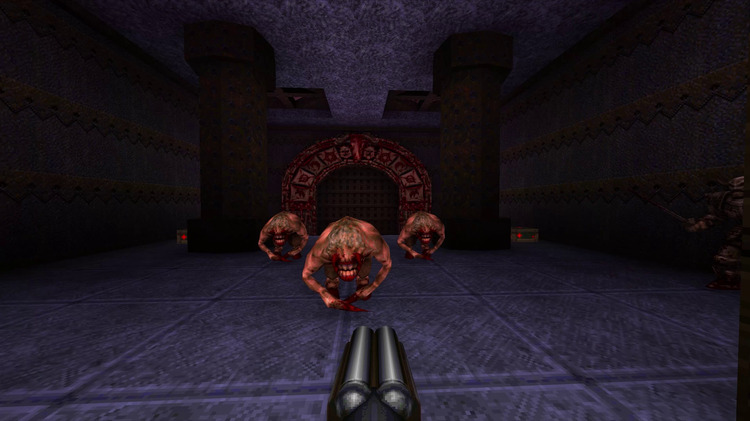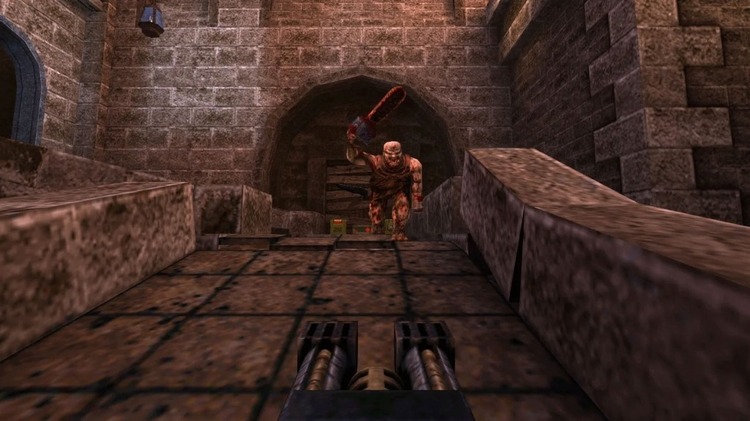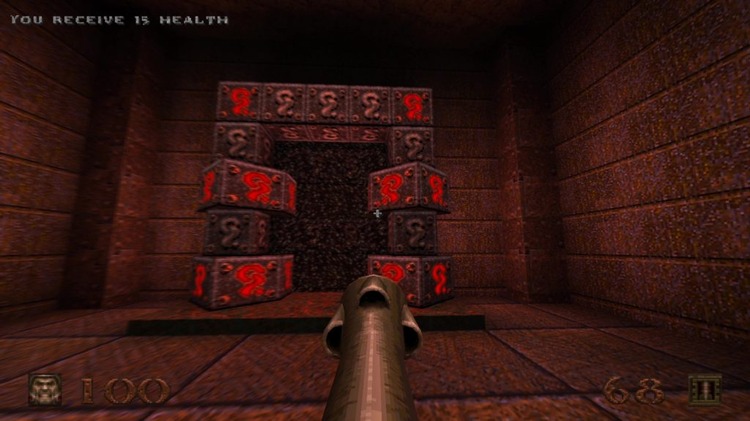Quake 1
< Back



| Quick Info | |
|---|---|
| Mods available? | Many |
| Year released | 1996 |
| Available from | Steam
GoG |
| Category | FPS |
| Time to Beat | 5.5 Hours |
| Played? | Yes |
| Game length provided by HowLongToBeat |
|
Quake is one of the first fully 3D first person shooters. Developed by ID software and released in 1996, the game helped popularize multiplayer deathmatches and the engine it was built on was used in various other innovative FPS games for the time. The combat and especially the movement of the game is fast paced and engaging, along with an excellent soundtrack by Nine Inch Nails, this game scratches the FPS itch.
The game is available from both Steam and GoG at a very discounted price most of the time. Even when not on sale - the enhanced edition will only run around $5. Whether it be the single player or multiplayer gameplay that draws you in, the base version of Quake will absolutely provide good value at that price.
Why should this game be played?
This game is a challenging, arcade like FPS experience. The character movement is fast, somewhat floaty and carries momentum as you cruise through the levels, dodging enemies and spreading destruction. For the time, the level design and different approach to enemies and weapons set Quake apart. While it lacks in some areas, mainly the couple boss fights the player is faced with. It's a great game to jump into, blow up some monsters and die over and over again.
Within the original game there are four episodes to play through, consisting of around eight levels each, along with a few hidden missions. Before players even get into the game itself, you are dropped into a room with branching pathways, moving away from the start screen difficulty mode selection of Doom, this is how players determine how punishing the game will be. The game can be played on easy, medium and hard difficulties, with a nightmare difficulty available if the player can find the hidden entrance.
Across these episodes, players will come across eight different weapons, ranging from a standard shotgun to a rocket launcher and a lightning bolt gun. As fodder for all the projectiles you will be slinging, there are sixteen types of enemies scattered around the levels, including the two somewhat lackluster bosses at the end of episode one and four.
The makeup of the levels sticks to some of the standard conventions that were established in early FPS games like Doom, with keycards scattered around some levels to allow for access to areas, new enemies emerging after triggers or events and plenty of walls to be shot or pushed to uncover secrets. What Quake does do differently is the verticality of these levels. With the additional of full 3D graphics, designers had the opportunity to build up and down much more than they did when designing Doom. This allows for some really confusing levels, but also enhances the feeling of being stuck in a medieval castle overrun with monsters.
Where to get the game
The Quake Enhanced Edition is regularly sold for around $10 USD on both Steam and GoG, with sales bringing the price down to 50% of that every 6 weeks or so.
Which one should I play?
The versions of Quake available through Steam or GoG will come with the enhanced edition, along with the original game. If you are looking for a straightforward path to playing the game through and enjoying it as an experience, the enhanced edition is the way to go.
The enhanced edition of Quake was released in 2021 and is a version of the game ported to the Kex Engine by Nightdive Studios. This edition features support for widescreen resolutions up to 4k, higher framerates, optional graphical updates, and a new expansion titled "Dimensions of the Machine". The enhanced version of the game is also able to run many mods, however if you want to dive deep into the world of Quake modding, getting a source port of the game may be required.
Modding and Source Ports
There is a large catalog of compatible mods for the enhanced version of the game, however prior to this version being released the Quake community took it upon themselves to create source ports of the game and build mods from that.
A source port is a recreation of the source code for the Quake engine to other platforms. In many cases the source code ports will upgrade the capabilities of the game engine, granting mod developers the chance to expand the original game's content and compatibility over what was originally created. The site Slipgate Sightseer has an excellent beginners guide to source ports and understanding the Quake install directory.
There are many source ports available for Quake, with extensive mod packages built within them. Arguably, Quake is one of those games with enough fanmade content that you could continue to play it forever, always finding new experience.
Additional Resources
| Resource | Link | Description |
|---|---|---|
| Game Info | Quake Wiki |
This site has tons of information on modding, maps and gameplay tips. |
| Slipgate Sightseer |
A Quake modding website with tons on content to enhance your playthrough or provide an entirely new experience. | |
| Youtube Content | Quake Speedruns Explained |
Quake has a great sense of speed and watching someone speedrun it is a joy. |
| Ahoy - Quake Retrospective |
Youtuber Ahoy has excellent quality retrospectives, with Quake being one of them. |
